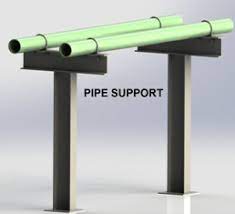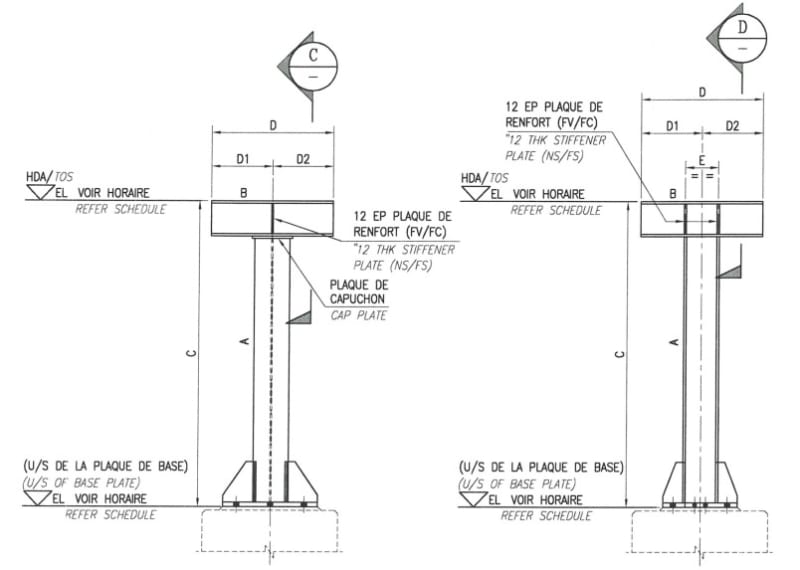Navigation
Install the app
How to install the app on iOS
Follow along with the video below to see how to install our site as a web app on your home screen.
Note: This feature may not be available in some browsers.
More options
Style variation
-
Congratulations cowski on being selected by the Eng-Tips community for having the most helpful posts in the forums last week. Way to Go!
You are using an out of date browser. It may not display this or other websites correctly.
You should upgrade or use an alternative browser.
You should upgrade or use an alternative browser.
PIPE SUPPORT-COLUMN ORIENTATION
- Thread starter tmgczb
- Start date
- Status
- Not open for further replies.
These supports are sometimes called "T-poles" or "T-posts" ... they are typically tall and slender and used when there is no alternative

Sometimes a pipe is used for the column member, which has equal stiffness in all directions
Additionaly, you should note that these t-pole suports are NOT supposed to be used where the piping system will develop axial loads ! (e.g. where the pipe needs an anchor at that point)
The answer to your question is:
-- "Type 1 offers "column bending stiffness" along the axis of the single supported pipe or pipes, where it is not necessary or desired,"
-- "Type 2 offers "column bending stiffness" orthogonal to the axis of the supported pipe which is desired and is therefore MORE COMMON"
I am not comfortable with your awkward third world terminology "column bending stiffness" .... but used it anyway in my response
If you were to develop a composite structural model with a series of supported piping systems and REALISTIC values for "C", then the answer would be obvious

MJCronin
Sr. Process Engineer

Sometimes a pipe is used for the column member, which has equal stiffness in all directions
Additionaly, you should note that these t-pole suports are NOT supposed to be used where the piping system will develop axial loads ! (e.g. where the pipe needs an anchor at that point)
The answer to your question is:
-- "Type 1 offers "column bending stiffness" along the axis of the single supported pipe or pipes, where it is not necessary or desired,"
-- "Type 2 offers "column bending stiffness" orthogonal to the axis of the supported pipe which is desired and is therefore MORE COMMON"
I am not comfortable with your awkward third world terminology "column bending stiffness" .... but used it anyway in my response
If you were to develop a composite structural model with a series of supported piping systems and REALISTIC values for "C", then the answer would be obvious

MJCronin
Sr. Process Engineer
- Thread starter
- #4
MJCronin said:But forces in horizontal direction are mainly along axis of pipes.
- Thread starter
- #6
Tmgczb:
The pros and cons, as I see them..., The right hand detail, Type 2, is the preferred column/post orientation in most cases, for the following reasons:
Along the length of the pipes, you will at least have forces and movement due to thermal expansion and contraction of the pipes. A degree or two of column top movement/lean can be tolerated and designed for over a number of support bays. Then every so often, every so many bays, you might x-brace a bay, along the axis of the pipes, to control and contain this movement. Slip joints or saddles might come into play in this longitudinal loading and movement too. And, you may have some support points which are fixed in terms of these longitudinal loadings and movements, for various reasons. And, the weak axis bending strength of the columns lends itself to the above considerations.
On the other hand, the strong axis bending of the columns and their bases/foundations is the primary means (only means) of supporting lateral loads (wind, EQs, etc.) in the direction perpendicular to the pipeline, not much sharing or redistribution btwn. columns here. These are often the greater lateral loads at the tops of the columns, and the columns are more difficult to brace (guy wires, etc.), in this perpendicular direction. These guy wires end up outside the pipeline right-of-way, or out in a travel path, etc. The basic column strength vs. gravity load only, is pretty much the same for either orientation, but then you must combine this with the column bending due to the various lateral loads in each direction.
The pros and cons, as I see them..., The right hand detail, Type 2, is the preferred column/post orientation in most cases, for the following reasons:
Along the length of the pipes, you will at least have forces and movement due to thermal expansion and contraction of the pipes. A degree or two of column top movement/lean can be tolerated and designed for over a number of support bays. Then every so often, every so many bays, you might x-brace a bay, along the axis of the pipes, to control and contain this movement. Slip joints or saddles might come into play in this longitudinal loading and movement too. And, you may have some support points which are fixed in terms of these longitudinal loadings and movements, for various reasons. And, the weak axis bending strength of the columns lends itself to the above considerations.
On the other hand, the strong axis bending of the columns and their bases/foundations is the primary means (only means) of supporting lateral loads (wind, EQs, etc.) in the direction perpendicular to the pipeline, not much sharing or redistribution btwn. columns here. These are often the greater lateral loads at the tops of the columns, and the columns are more difficult to brace (guy wires, etc.), in this perpendicular direction. These guy wires end up outside the pipeline right-of-way, or out in a travel path, etc. The basic column strength vs. gravity load only, is pretty much the same for either orientation, but then you must combine this with the column bending due to the various lateral loads in each direction.
- Thread starter
- #10
dhengr said:There is no X brace nor tie beams between any 2 posts. All T posts are isolated.
- Status
- Not open for further replies.
Similar threads
- Locked
- Question
- Replies
- 2
- Views
- 3K
- Locked
- Question
- Replies
- 1
- Views
- 1K
- Locked
- Question
- Replies
- 1
- Views
- 2K
- Replies
- 0
- Views
- 3K
- Replies
- 3
- Views
- 628

